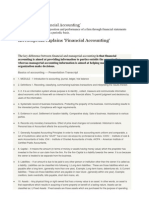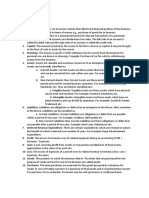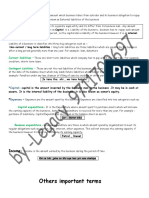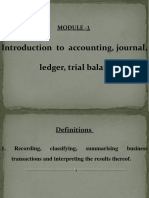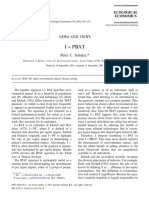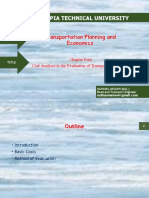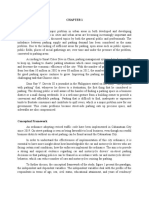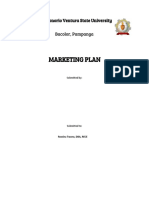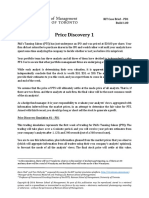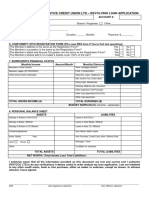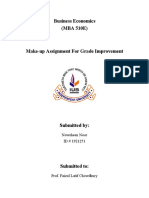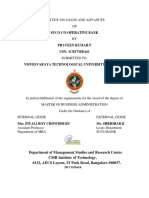CHAPTER -2
BASIC ACCOUNTING TERMS
1. CAPITAL
It refers to amount of money or money's worth (goods and assets) invested by the proprietor in a
business enterprise. From the point of view of business, capital is a liability towards the owner.
Capital is shown in the Liabilities side of Balance Sheet.
It is also known as owner’s equity or net worth or net assets or internal liability.
It is also formulated as excess of assets over outside liabilities.
Capital (C) = Total Assets (A) - Total External Liabilities (L)
Example: Mr. Ram has decided to start a business with Cash Rs.5,00,000, Machinery Rs.2,00,000
and Goods worth Rs.3,00,000. It means his total capital in the business is Rs.10,00,000.
Capital can be further classified in the following categories:
Fixed Capital: Amount spent to acquire the fixed assets.
Floating Capital: Purchase of goods/services/investments etc. with intention of sales.
Working Capital: Amount required for day-to-day activities of the business. It is the
difference of current assets and current liabilities.
Working Capital = Current Assets (CA) - Current Liabilities (CL)
Opening Capital: Money or money’s worth invested by the owner to commence a business.
Additional Capital: Extra money or money’s worth invested by the owner during the year.
Closing Capital: Capital at the end of the accounting period is known as closing capital.
It is calculated as follows:
Closing Capital = Opening capital + Additional Capital + Profit - Drawings
2. DRAWINGS
It is the amount of money or the value of goods or assets which is withdrawn by the proprietor or
partner (in case of partnership) of a business for his domestic or personal use.
Any private payment made out of business money are also called Drawings.
Goods so taken by the proprietor or partner are valued at their purchase cost. Drawings reduces the
investment (or capital) of the owners.
Drawings by the proprietor or partner is debited to Drawings Account. At the time of preparing
Balance Sheet, it is deducted from the capital of the proprietor or partner, as the case is.
Examples:
(i) Mr. Ram has withdrawn Rs.10,000 per month out of business money. It means his total
drawings during the year Rs.1,20,000.
(ii) LIC premium paid, Income Tax paid, Salary paid to domestic servant, Rent paid for
proprietor resident out of business funds are drawings.
�3. GOODS
Goods includes all those things which are purchased for resale purpose.
OR
Which are used for producing the finished product which are also meant for selling.
It means all items in which a business deals, that is goods for that business.
Examples:
For a furniture dealer, chairs, table is termed as goods.
For a stationeries dealer, books, pen notebook is termed as goods.
Goods may be divided into four categories:
Purchases
The term purchases is used only for the purchases of goods in which the business deals
means items bought for resale purpose.
The term purchases include both cash purchases and credit purchases of goods.
When amount is paid to suppliers immediately is known as cash purchases but if amount is
not paid to suppliers for goods purchases is known as credit purchases.
Example:
If a cloth dealer purchases cloth for sale, the cloth so purchased will be called as purchases.
Sales / Revenue from Operations
The term sales is used only for the sale of those goods which are purchased for resale
purpose. It also includes revenue from services provided to customers.
The term sales include both cash sales and credit sales of goods.
When amount is received from customers immediately is known as cash sales but if the
amount is not received at the time of sales immediately is known as credit sales.
Example:
If a cloth dealer sells cloth, it will be termed as sales.
Purchases Return/Returns Outward
When goods purchased are returned to suppliers due to any reason (defective or not as per
specification), is known as purchases return. It is also known as returns outward.
In order to calculate net purchases, purchases return is deducted from purchases.
Sales Return/Returns Inward
When goods once sold are returned by customers to us due to any reason (defective or
not as per specification), is known as sales return. It is also known as returns inward.
In order to calculate net sales, sales return is deducted from sales.
4. REVENUE
Revenue refers to amount received or receivable from sale of goods and from services provided to
customers. It means income of regular nature from any source.
OR
The inflow of assets due to exchange of goods and services is called revenue. It is the amount
which as a result of business operations is added to the capital.
Revenue is a receipt from sales, services and sources like rent, interest, commission, etc.
� Examples:
Amount received or receivable from sale of product.
Amount received or receivable from service provide to customers.
Earning from commission, rent and interest etc.
5. EXPENSES
Expenses is the cost incurred in producing and selling the goods and services. It means cost
incurred to generate revenue.
OR
The money spent by the business to earn revenue is called an expense, 'Expense' is the cost of the
things and services used for the purpose of earning revenue. The benefit of expense is expired
during the accounting period. It means benefit of expense can be enjoyed within one accounting
period only.
Examples:
Cost of goods sold
Amount paid in cash for rent, salary and wages etc.
Decrease in the value of assets caused by use of such assets in that business.
writing off a part of fixed assets, i.e., depreciation.
an amount written off out of a current asset (say bad debts).
decline in the value of assets (say investments).
An expense is transferred to the debit of Trading Account or Profit and Loss Account.
Expenses may be divided in to two parts:
Outstanding Expenses (Expenses due but not yet paid)
When expense of an accounting period remains unpaid at the end of the accounting period,
but the benefit of that unpaid expense is already taken, it is called outstanding expense.
Example:
Salary payable to the manager for the year is Rs.24,000 (Rs.2,000 per month). At the end of
the accounting period it is found that salary is paid only for 10 months, i.e., salary for two
months Rs.4,000 is outstanding.
Outstanding salary Rs.4,000 will be shown in Profit and Loss Account and Liability side of
Balance Sheet.
Prepaid Expenses (Expenses paid in advance)
Expenses which are paid in advance in the normal course of business operations. If the benefit
of such expense is not received within one accounting period or amount which is paid but
benefit of that is not received up to the end of accounting period, is called prepaid expense.
Example:
Rent Rs.6,000 has been paid for one year beginning on 1st July 2021. The financial year ends
on 31st March 2022. It means premium for 3 months, i.e., 1st April, 2022 to 30th June 2022
amounting to Rs.1,500 has been paid in advance.
Thus, the amount of premium paid in advance (Rs.1,500) is prepaid expense.
�6. INCOME
Excess of revenue over expenses in known as income.
Income = Revenue - Expenses
Example:
Goods costing Rs.4,00,000 are sold for Rs.5,00,000
Here, Revenue = Rs.5,00,000 and Expenses = Rs.4,00,000
Therefore, Income = Rs.(5,00,000 – 4,00,000) = Rs.1,00,000
Income is divided into two categories:
Accrued Income (Income earned but not yet received)
Accrued income is income which has been earned but not yet received. These are shown in the
assets side of Balance sheet.
Unearned Income (Income received in advance)
Unearned income means money received in advance but not earned. This unearned amount is
recorded in a liability account such as unearned income or income received in advance account.
After the amount has been earned, the liability account is reduced and a revenue account is
increased.
7. COST
Cost means amount of expenses incurred actually or notional on producing a particular product. It
means expenses incurred on manufacturing a product.
Example:
For manufacturing a fan, expenses incurred by company
Material Rs. 600 Labour/Wages Rs.200 Other Expenses Rs.100
It means Cost of fan Rs.900
8. PROFIT
It is the excess of total revenue over total expenses of a business enterprises for an accounting
period.
OR
Profit means income earned by the business from its Operating Activities, i.e., the activities carried
out by the enterprise to earn profit. For example, profit earned from sale of goods and/or rendering
of services.
It is of regular nature.
Profit = Total Revenue - Total Expenses
Example:
Sales of Rama Ltd. for the year 2016-17 Rs.10,00,000 = Total Revenue
Expenses of Rama Ltd. for the year 2016-17 Rs. 8,00,000 = Total Expenses
Profits of Rama Ltd. for the year 2016-17 Rs. 2,00,000
Profit is divided into two categories:
Gross Profit
Gross profit or margin means total profit earned by the business. It is the excess of the proceeds of
goods sold and services rendered during a period over their cost, before taking indirect expenses.
� For example administrative expense, selling and distribution expense and expenses related to
finance. In case the result is negative it is known as gross loss (when revenue falls short of
cost).
Net Profit
To know the net profit of the business, all non-operating expenses are deducted and all
non-operating incomes are added to the operating profit.
Net Profit = Operating Profit - Non-Operating Expenses + Non-Operating Incomes
9. GAIN
It is monetary benefits, surplus or advantages resulting from events or transaction which are
incidental to the business such as surplus arises from sale of fixed assets, compensation received
and winning from court case.
OR
Gain is the increase in owner’s equity resulting from transactions other than the day to day
transactions from irregular or non-recurring nature. Stating differently, it is a profit that arises from
transactions which are not the Operating Activities of the business but are incidental to it such as
gain on sale of land, machinery or investments.
It is of irregular nature.
Example:
Building book value Rs.80,000 sold for Rs.92,000, surplus of Rs.12,000 is a gain.
10. LOSS
The term loss conveys the two different meanings:
It is the excess of total expenses over total revenue of a business enterprises for an accounting
period.
Loss = Total Expenses - Total Revenue
Example:
Sales of Mohan Ltd. for the year 2021-22 Rs.10,00,000 = Total Revenue
Expenses of Mohan Ltd. for the year 2021-22 Rs.13,00,000 = Total Expenses
Loss of Mohan Ltd. for the year 2021-22 Rs. 3,00,000
OR
Loss also refers to such activities of the business for which no benefits is received by the firm.
Examples: Loss by fire, loss by theft
Machinery destroyed by fire of book value Rs.60,000 and compensation received from insurance
company Rs.50,000. It means loss of Rs.10,000.
OR
Loss is that amount or value by which the cost of a business exceeds its revenue.
Losses may be operating or non-operating.
For example, loss by fire, loss by theft, embezzlement, etc., are non-operating losses whereas bad
debts, loss on valuation of inventory etc., are operating losses.
�11. ACCOUNTING YEAR OR FINANCIAL YEAR
It refers to period of twelve months which is started on April 1 and ends on March 31 of the next
year. Account of the business concern are prepared on the basis of accounting year.
Example;
2021-22 is an accounting year, (01/04/2021 to 31/03/2022) OR For the year ended 31/03/2022
12. STOCK AND INVENTORY
The term stock include values of goods lying unsold on a particular date.
Stock may be:
Closing Stock = Value of goods lying unsold at the end of accounting period.
It represents the value of goods which remain unsold at the end of trading period. Generally,
closing stock does not appear inside the trial balance. In that case, it is shown on the credit side
of trading account. But sometimes, when it appears inside the trial balance, it is not to be shown
on the credit side of trading account, but appears only in the balance sheet as an asset.
Closing stock should be valued at cost or market price, whichever is less.
Opening Stock – Value of goods laying unsold at the beginning of accounting period.
Stock in hand in the beginning of an accounting period is known as opening stock.
(Closing stock of last accounting period will be treated as opening stock in the beginning
of the next accounting period).
It must have been brought into books with the help of opening entry, so it always appears inside
the trial balance.
Inventory may be of following four types:
Inventory of raw material (goods lying unprocessed/unused).
It is the stock of raw material, which was purchased earlier and still unused.
Examples:
Value of cotton in case of cloth mills will be treated as stock or raw material.
Crude iron in the utensils industries.
Cloth to be used for stitching shirts.
Inventory of work in progress (goods on which further processing is yet to be done).
It is the stock of semi-finished product, which is in the process of completion. To calculate
the value of work in progress, following things should be kept in mind:
Cost of raw material used, Cost of labour, Power, Fuel and Other expenses (Production
Cost)
Inventory of finished goods (which are completed in all respect and no further processing is
required).
Inventory of stock in trade (finished goods unsold, purchased for resale purpose).
Stock (Trading Business) and Inventory (Manufacturing Business).
13. TRADE RECEIVABLES
It refers to the amount receivable for sale of goods sold or services rendered in the normal course
of business. It includes both debtors and bills receivable.
� DEBTORS (Customers)
The term debtors represents those person or firm to whom goods have been sold or
services renderedon credit basis and payment has not been received from them.
It means who owes some amount to the business.
Example:
If goods worth Rs.10,000 have been sold to Mohan on credit, he will continue to
remain debtorsof the business as long as, he does not make the full payment.
In case he makes a payments of Rs.2,000 he will still be a debtor for Rs.8,000.
BILLS RECEIVABLE (B/R)
It is a written documents drawn by Drawer (Seller) and accepted by Drawee (Buyer), in
which sellerordered to the buyer to pay specific amount at specific future date.
It is known as B/R for Drawer and an asset.
14. ASSETS
Assets are valuable resources owned by a business enterprises which can be measured in terms of
money.
Anything which will enable a business enterprises to get cash or a benefit in future is an assets.
Material things owned by the business are called assets.
Examples: Land, Building, Machinery, Plant, Furniture and Fittings, Closing Stock, Cash, Bank.
Features: Owned by business, Value attached, Acquired at a measurable money cost
Classification of Assets:
Current Assets (Floating Assets / Circulating Assets / Active Assets / Short Lived Assets)
Current assets are those assets which can be converted into cash within twelve months or which are
meant for sale.
Examples: Cash, Bank balance, Bill Receivable, Closing Stock, Debtors, Prepaid Expense and
Accrued Income.
Non-Current Assets (Fixed Assets)
Non-Current Assets are those assets which are held for long term use in the business for the purpose
of producing goods or services and are not meant for resale. These assets increase the earning
capacity of the business.
Examples: Fixed assets, Non-current Investments, Long-term Loans and Advances and Other
Non-current Assets.
Fixed Assets
Fixed assets are those non-current assets of an enterprise which are held not for resale but
with the purpose to increase its earning capacity.
The assets are further classified into categories:
Tangible Assets
Tangible assets are those assets which can be seen and touched. These assets have a
physical existence.
Examples: Land, Building, Machinery, Plant, Furniture and Fittings, Live Stock.
� Intangible Assets
Intangible assets are those assets which cannot be seen and touched. These assets do not
have a physical existence.
Examples: Goodwill, Trademark, Patent Right, Copy Right.
Capital Work in Progress: It means that fixed tangible assets are under construction.
Example: Office building is under construction and may take 3-5 years for the
completion.
Intangible Assets under Development
It means that fixed intangible assets are under development.
Example: Software is under development and may take 2-3 years for full development.
Wasting Assets
Wasting assets are those assets which are consumed through being worked or used. It also includes
assets which get exhausted with lapse of time.
Examples: Oil Wells, Coal mine, Leasehold properties, Sand mines.
Fictitious Assets (Nominal Assets)
Fictitious assets are those assets which do not have any physical existence and they are expected
not to realize any value or render any services in future.
These assets are to be written off against Profit and Loss Account.
Examples: Advertisement Suspense, Discount on issue of debentures.
15. TRADE PAYABLES
It refers to the amount payable for purchase of goods or services taken in the normal course of
business.It includes both creditors and bills payables.
CREDITORS (Suppliers)
The term creditors represents those person or firm from whom goods have been
purchased orservices taken on credit basis and payment has not been made to them.
It means some amount is still owing to them..
Example:
If goods worth Rs.12,000 have been purchased from Amit on credit, he will continue
to remaincreditor of the business as long as, the full payment is not made to him.
In case amount paid to Amit Rs.3,000 he will still be a creditor for Rs.9,000.
BILLS PAYABLE (B/P)
It is a written documents drawn by Drawer (Seller) and accepted by Drawee (Buyer), in
which sellerordered to the buyer to pay specific amount at specific future date.
It is known as B/P for Drawee and a liability.
16. BUSINESS TRANSACTION
A business transaction is an economic activity of the business that change its financial position.
Whenever any business transaction takes place, it results in change in the value of some assets,
liabilities and capital.
� FEATURES:
Economic activity
Change in financial position
Expressed in terms of money
Cash and Credit transaction
Dual Aspect or two sides - Receiving’ (Debit) and ‘Giving’ (Credit)
Relationship with the Mode of Settlement of
Accounting Unit Value
Internal Transaction External Cash Credit
Transaction Transaction Transaction
OR
Or
Accounting Transaction,
e.g., Business
Transaction
Depreciation on Fixed Assets
17. EVENTS
The consequence or result of business transaction is known as Events.
Business transaction:
Goods purchased for Rs.80,000.
Goods sold for Rs.95,000.
Event:
Profits computed Rs.15,000 (95,000 - 80,000)
18. LIABILITIES
It refers to the amount which the firm owes. It is the obligation or debt that an enterprise has to
pay at some time in future.
Examples: Loan from bank, Creditors
The liabilities are further classified into five categories:
Non-Current Liabilities (Long Term Liabilities / Fixed Liabilities)
It refers to those liabilities which are to be redeemed (repayable) after a long period of time,
normally after twelve months.
Examples:
Loan from bank, Debentures
Current Liabilities (Short Term Liabilities)
It refers to those liability which are to be repayable normally with in twelve months.
Examples:
Creditors, Bank overdraft, B/P, Outstanding Expense.
� Contingent Liabilities
Contingent Liabilities are those liabilities which may or may not arise in future. These are not real
liabilities. It depends upon the happening of an events. If event occurs, it become actual liabilities.
Examples:
Bill Receivable discounted from bank, Guarantee given to bank, Claims against company but not
acknowledged as debt.
Internal Liability
All amount which a business entity has to pay to the proprietor or owners are known as internal
liability.
Examples:
Capital, Accumulated Profits (Profit and Loss A/c).
External Liabilities
All amounts which a business entity has to pay to the outsiders are known as external liabilities.
Examples:
Creditors, Bank Loan, Bills Payable, Outstanding Expenses.
19. ACCOUNT
Account is a summarized records of relevant transaction at one place related to a particular head.
It records not only the amount of transaction but also their effect and direction.
Its Performa is of ‘T’ shape.
Left side of account is known as Debit side (Dr.).
Right side of account is known as Credit side (Cr.).
Examples:
All transaction related to cash are recorded at one place, known as Cash Account.
20. RECEIPTS
Receipts refers to amount received or receivable by the business organization due to selling goods,
providing services or selling assets.
Receipts may be divided into two parts:
Revenue Receipts
It is the amount received or receivable in the normal course of business activities. It means against
sale of goods or providing services. These are recurring in nature.
Capital Receipts
It is the amount received or receivable not due to business activities. It means against sale of assets
or capital contributed by owners or loan taken from bank. These are non-recurring in nature.
21. EXPENDITURE
As we know that benefit of expense is enjoyable only for one accounting period whereas benefit
of expenditure is enjoyable for long period.
Any disbursement of cash or transfer of property or incurring a liability for the purpose of
acquiring assets, goods or service is called expenditure.
Expenditure increases the earning capacity of the business. It means any type of payment for the
� receipts of benefits is termed as expenditure.
Examples:
Purchase of machinery, Purchase of furniture, Salary paid, etc.
Expenditure may be classified into three categories:
Capital Expenditure
It refers to an expenditure incurred for acquiring or increasing the value of fixed assets.
Capital expenditure yields benefits over a long period of time.
Capital Expenditure is shown on the assets side of the Balance Sheet.
Examples: Building purchased, Installation charges on machinery.
Revenue Expenditure
It refers to an expenditure which are incurred in day to day running and operating activities of
business. The benefits of revenue expenditure yields with in same year.
It has direct relationship with revenue or with the accounting period, e.g., salaries,
Examples: Cost of goods sold, Rent paid, Salary paid, Electricity expenses, etc.
Revenue Expenditure is shown on the debit side of the Trading Account or Profit and Loss Account,
in the case of proprietorship or partnership enterprises and in the Expenses part of the Statement of
Profit and Loss, in the case of companies.
It is shown on the debit side of the Income and Expenditure Account in the case of Not-for-Profit
Organisations.
Deferred Revenue Expenditure
It refers to revenue expenditure, the benefits of which is likely to accrue in more than one
accounting year.
Examples: Heavy advertisement expenditure incurred in introducing in a new market.
22. DISCOUNT
It is a rebate or an allowance given by the seller to the buyer. It is of two types.
Trade Discount
It is a rebate allowed by seller to buyer at a fixed percentage of the list price. It is not recorded in
books. The main purpose of trade discount is to increase the sale.
Example:
Raju sold goods to Robin at a list price of Rs.30,000 at 15% trade discount. In such a situation,
sales will be recorded at Rs.25,500 and trade discount of Rs.4,500 will not be recorded at all.
Cash Discount
It is a rebate allowed by seller to buyer for making prompt or quick payments. It is recorded in books.
The main purpose of cash discount is quick recovery of cash. It is an expense for the person who
allows the discount and income for the receiving party.
Example:
Jack sold goods worth Rs.2,000 to John and received cash and allowed 5% cash discount. In such
a situation, John will get Rs.100 cash discount.
�23. VOUCHER
Voucher is an evidence of a business transaction. It is a document on the basis of which business
transaction are recorded. A separate voucher is prepared for each business transaction by
accountant and each voucher is numbered and countersigned by an authorized person.
It proves the genuiness of business transaction.
24. PROPRIETOR
The person who makes the investment and bear all the risks connected with the business is called
proprietor. He is also known as owner of business.
25. ENTRY
A transaction and event when recorded in the books of accounts (JOURNAL) is known as entry.
26. DEPRECIATION
Depreciation means decrease in the value of fixed assets due to use or passage of time.
27. BAD DEBTS
Irrecoverable amount from debtors due to their insolvency is known as bad debts.
28. INSOLVENT
Insolvent is a person or enterprises which is not in a position to pays its debt out of his assets and
court has declared him bankrupt.
A person become insolvent when his liabilities are more than his assets.
29. BOOK VALUE
Book value is the amount at which an item appears in the books of accounts.
30. ENTITY
An entity refers to an economic unit, which is engaged in performing economic activities.
e.g., Hero Cycles.
31. WORKING CAPITAL
Excess of Current assets over Current liability is known as working capital.
Working Capital = Current Assets - Current Liabilities
32. BALANCE SHEET
It is a statement of assets and liability which shows the financial position of an enterprise on a
particular time.
33. TURNOVER
Turnover means total sales of business during a particular period.
34. STORES
It refers to the material held by business enterprises for the purpose of consumption in the business
and not for resale
Example: Lubricants oil, packing materials, belts
35. INVESTMENT
It refers to deployment of funds in shares and debentures of companies with intention to earning
return, Interest or dividend.
36. LIVE STOCK
It refers to animal used in business such as horses, elephants etc.
�37. GOODS AND SERVICES TAX (GST)
Goods and Service Tax (GST) is an indirect tax levied in India on the sale of goods and services.
Goods and services are divided into different tax slabs and a different percentage of tax (GST) is
fixed for each slab, for example, 0%, 5%, 12%, 18% and 28%.
The main purpose of implementing GST was to replace the various taxes (old and complicated
tax system) levied by the central and state governments.
The tax (GST) came into effect from July 1, 2017.
Example: Suppose if Rs.20,000 GST is collected in an intra-state (within the same state)
transaction, then Rs.10,000 will be shared by the central government and remaining
Rs.10,000 will be shared by the state government.
Note: Input word is used when tax is paid and output word is used when tax is collected.
1. CGST AND SGST
The amount collected through GST will be shared by the central and the state government in
the 50:50 ratio.
Example:
If a good is taxed at 12%, out of this, 6% will go to the centre and the remaining 6% will go
to the state where the good is consumed. The share of GST going to the central government
is known as Central GST (CGST) and the remaining share going the state is known as State
GST (SGST).
2. IGST (INTEGRATED GST)
The IGST will take place only when the commodity is produced in one state and is traded to
another state (interstate trade). In such a case 50% of the GST will go to the central government
and remaining 50% to the state where goods are consumed (it does not belong to the state where
goods are manufactured).
3. CHARACTERISTICS/FEATURES OF GST
Most of the important indirect taxes of the centre and states are integrated under the GST.
The GST integrates Goods and Service Taxes into one unified tax regime.
All Goods and Services are divided into different slabs and different percentage of tax is
fixed for each slab.
It is a compulsion for traders to get registered under GST.
The centre and states will share GST tax revenues at 50:50 ratio which will be a great source
of income for both the governments.
� 4. MAIN OBJECTIVES OF GST
One Country - One Tax or to simplify the tax system.
No Tax on manufacturing. GST is based on the consumption.
Uniformity in the system of GST Registration, payment and Input tax Credit.
To remove all old Indirect taxes on single transaction.
To reduce the tax evasion and corruption.
To increase the productivity and GDP of the country.
38. CASH AND CASH EQUIVALENTS = Cash + Cash Equivalents
Where, Cash means Cash in hand and Cash at Bank, and
Cash equivalents are short term, highly liquid assets which can be converted into cash in a
very short period of time. (Say, 3 months).
Cash and Cash Equivalents
Cash Cash Equivalents
(i) Cheques in hand (ii) Drafts in hand
Cash in hand
Cash at bank (iii) Marketable Securities (short-term)
(iv) Short-term deposits (v) Commercial bills
(vi) Commercial Papers (vii) Treasury bills
(viii) Certificate of deposit (ix) Call money
39. OPERATING CYCLE
An operating cycle is the time between the acquisition of assets for processing and their realization
in cash and cash equivalents. Where the normal operating cycle cannot be identified, it is assumed
to have duration of 12 months.
40. HYBRID SYSTEM OF ACCOUNTING
Under hybrid system of accounting, both cash basis of accounting and accrual basis of accounting
are followed.

















